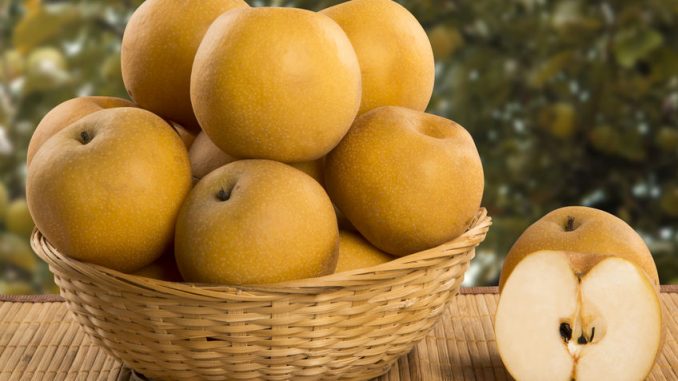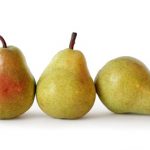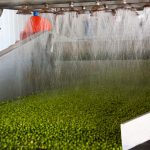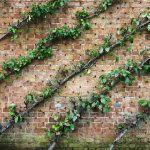
If you are fortunate enough to be offered a russett looking pear in Asia, it will no doubt me a sign of honour to the recipient because you have received what is often called an asian pear or nashi pear. These are now available in most supermarkets
Pyrus pyrifolia is a species of pear tree native to East Asia.
The tree’s edible fruit is known by many names, including: Asian pear, Chinese pear, Korean pear, Japanese pear, Taiwanese pear, and sand pear. Along with cultivars of P. × bretschneideri and P. ussuriensis, the fruit is also called the nashi pear. Cultivars derived from Pyrus pyrifolia are grown throughout East Asia, and in now in many countries inlcuding India, Australia, New Zealand, and the United States (e.g., California). Traditionally in East Asia the tree’s flowers are a popular symbol of early spring, and it is a common sight in gardens and the countryside.
The fruits are not generally baked in pies or made into jams because they have a high water content and a crisp, grainy texture, very different from the European varieties. They are commonly served raw and peeled. The fruit is large for a pear with a pronounced fragrance. It must be carefully wrapped as it has a tendency to bruise because of its juiciness. The fruit lasts for several weeks or more in a cold, dry place but is susceptible to scald.
Cultivars
Cultivars are classified in two groups. Most of the cultivars belong to the Akanashi (‘Russet pears’) group, and have yellowish-brown rinds. The Aonashi (‘Green pears’) have yellow-green rinds.
Important cultivars include:
- ‘Chojuro’ (ja:長十郎, Japan, 1893?) (‘Russet pears’)
- ‘Kosui’ (ja:幸水, Japan, 1959; the most important cultivar in Japan), (‘Russet pears’)
- ‘Hosui’ (ja:豊水, Japan, 1972) (‘Russet pears’)
- ‘Imamuraaki’ (ja:今村秋, Japan, native) (‘Russet pears’)
- ‘Nijisseiki’ (ja:二十世紀, Japan, 1898; name means “20th century”, also spelled ‘Nijusseiki’)[(‘Green pears’)
- ‘Niitaka’ (ja:新高, Japan, 1927) (‘Russet pears’)
- ‘Okusankichi’ (ja:晩三吉, Japan, native) (‘Russet pears’)
- ‘Raja’ (new) (‘Russet pears’)
- ‘Shinko’ (ja:新興, Japan, pre-1941) (‘Russet pears’)
- ‘Hwangkeum’ (ko:황금, zh:黄金, Korea, 1984, ‘Niitaka’ x ‘Nijisseiki’)
- ‘Huanghuali’ (not to be confused with the wood of Dalbergia odorifera, also called Huanghuali)
Nutritional Values
| Nutritional value per 100 g (3.5 oz) | |
|---|---|
| Energy | 176 kJ (42 kcal) |
|
Carbohydrates
|
10.65 g
|
| Sugars | 7.05 g |
| Dietary fiber | 3.6 g |
|
Fat
|
0.23 g
|
|
Protein
|
0.5 g
|
| Vitamins | Quantity %DV† |
| Thiamine (B1) |
1% 0.009 mg
|
| Riboflavin (B2) |
1% 0.01 mg
|
| Niacin (B3) |
1% 0.219 mg
|
| Pantothenic acid (B5) |
1% 0.07 mg
|
| Vitamin B6 |
2% 0.022 mg
|
| Folate (B9) |
2% 8 μg
|
| Choline |
1% 5.1 mg
|
| Vitamin C |
5% 3.8 mg
|
| Vitamin E |
1% 0.12 mg
|
| Vitamin K |
4% 4.5 μg
|
| Minerals | Quantity %DV† |
| Calcium |
0% 4 mg
|
| Magnesium |
2% 8 mg
|
| Manganese |
3% 0.06 mg
|
| Phosphorus |
2% 11 mg
|
| Potassium |
3% 121 mg
|
| Sodium |
0%
|
†Percentages are roughly approximated using US recommendations for adults.



Leave a Reply